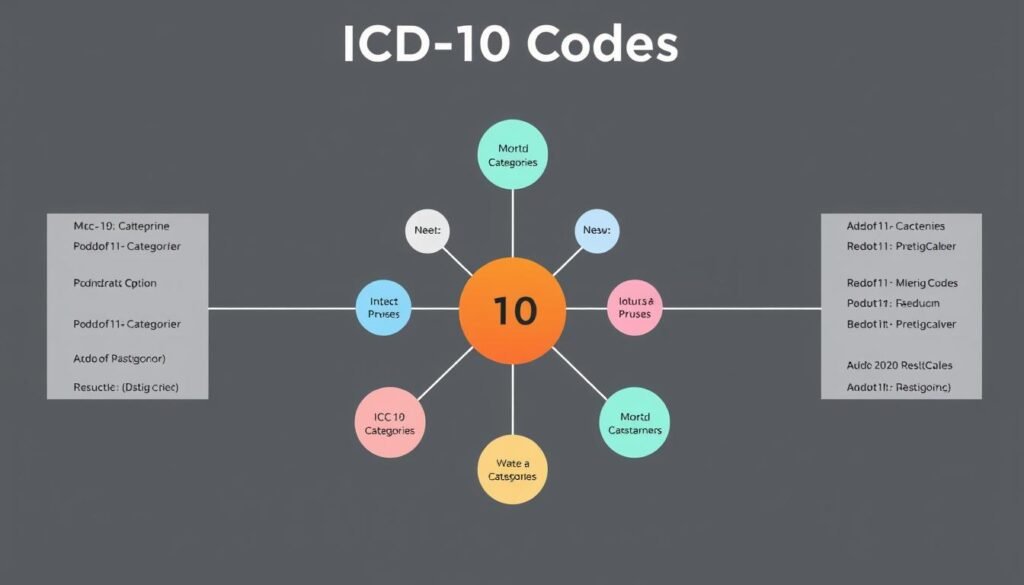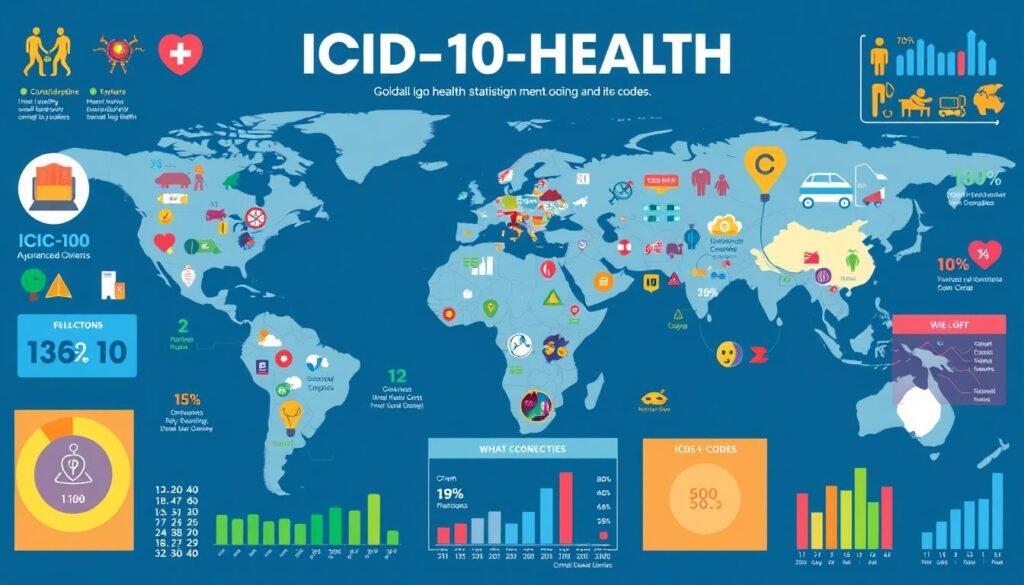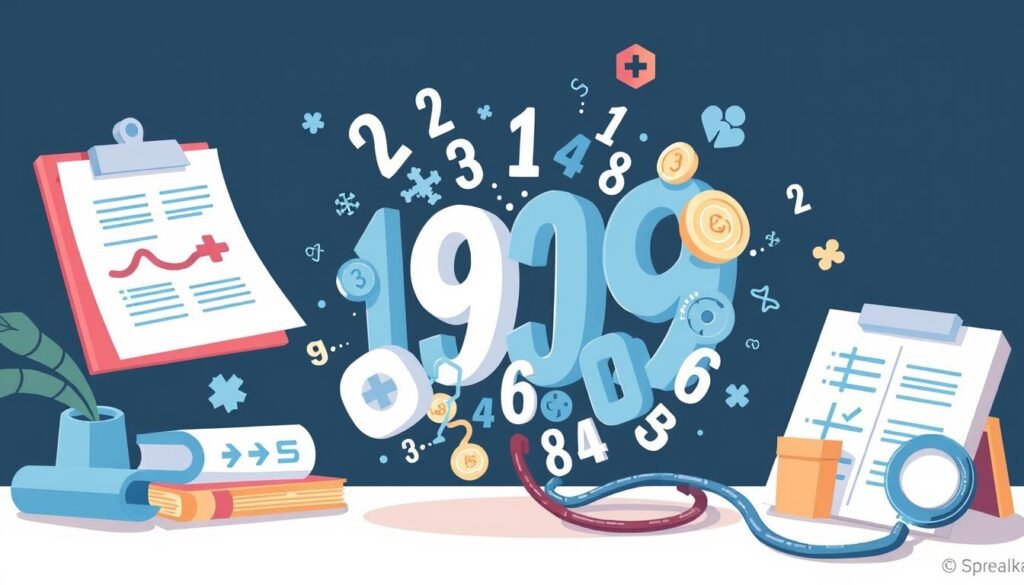The switch to ICD-10 in the U.S. changed the coding system from five to seven characters. This change has reshaped how healthcare workers document and diagnose, with over 68,000 codes for conditions. ICD-10 coding is key in healthcare today, improving how we handle data, communicate, and get paid.
ICD-10, or the International Classification of Diseases, 10th Revision, makes a standard way to classify medical issues and procedures. It lets healthcare workers share accurate info quickly, keeping the quality of care high. Knowing ICD-10 codes well is crucial for handling patients’ care, billing correctly, and working smoothly with insurance. Discover more about this topic at Understanding ICD-10 Codes.
Key Takeaways
- ICD-10 coding offers increased specificity for patient diagnoses compared to ICD-9.
- The system includes both ICD-10 CM for diagnosis and ICD-10 PCS for inpatient procedures.
- ICD-10 codes are crucial for accurate healthcare billing and reimbursement.
- The coding structure greatly improves clinical communication among healthcare providers.
- Understanding the importance of ICD-10 is essential for effective patient care management.
- Adopting sophisticated coding standards helps track public health trends.
Introduction to ICD-10 Coding
The Introduction to ICD-10 means big changes for medical coding. Now, we can better classify diseases and health issues. This new system comes from the World Health Organization. It takes over from ICD-9, used for many years. ICD-10 has about 19 times more codes for procedures and five times more for diagnoses, making healthcare quality easier to measure.
ICD-10 codes use three to seven characters. The first character is always a letter that matches its chapter. This makes organizing and understanding different health conditions simpler. The U.S. has its own version, which includes ICD-10-CM for all healthcare areas and ICD-10-PCS for hospital inpatient care.
From October 1, 2015, ICD-10-CM has made tracking patient care better. It helps with checking how well treatments work, keeping an eye on costs, and stopping billing issues. The guidelines by CM and NCHS spell out how to pick the right codes, especially for outpatients.
Accurate coding needs good teamwork between healthcare staff and coders. They must look at all patient notes to choose the right codes. This is super important in outpatient care. Switching to ICD-10 shows a strong move towards better healthcare. It aims for top-notch coding that leads to great care for everyone.
Explanation of ICD-10 Coding and its Importance in Healthcare
The ICD-10 coding system is key in today’s healthcare. It has over 70,000 codes. These cover explanation of ICD-10 coding, including diagnosis, symptoms, and treatments. Its codes range from 3-7 characters, giving detail on things like which side of the body and what treatment methods are used.
Overview of the ICD-10 System
ICD-10 is known worldwide. It makes communication better among healthcare workers. Its setup has sections for different body systems and problems, helping to group and report diseases correctly. For doctors, it means they can give personalized care. The ICD-10-CM system is praised for its detailed codes. These let health professionals keep up with health trends and policies.
Impact on Patient Care Management
Getting the diagnosis codes right is very important for getting paid. ICD-10’s detailed codes lessen claim rejections. This means healthcare workers get paid as they should. Besides, ICD-10 data aids in research. It reveals how different health issues are linked. This leads to better health policies and care, making patient outcomes better. The codes are also vital for public health. They help track diseases and start health programs.
| Feature | ICD-9 Codes | ICD-10 Codes |
|---|---|---|
| Number of Codes | 14,000 | 70,000+ |
| Character Length | 3-5 | 3-7 |
| Combination Codes | No | Yes |
| Clinical Documentation | Moderate | Improved |
| Support for Research | Limited | Enhanced |
The Transition from ICD-9 to ICD-10
The healthcare industry has seen a big Transition to ICD-10. This move introduces a better coding system. It also improves clinical documentation and coding.
ICD-10 has more codes and categories than ICD-9. This difference is quite big.
Key Differences Between ICD-9 and ICD-10
ICD-9 has 13,000 codes, but ICD-10 has over 155,000. This allows for more precise patient records. ICD-10 also helps in documenting underlying conditions, which side of the body is affected, and causes of injuries.
- ICD-9: 13,000 codes
- ICD-10: 155,000+ codes
This change betters data quality and outcomes in healthcare. It also changes how often certain illnesses are diagnosed. For example, more serious illnesses are diagnosed more often now.
Timeline of Implementation in the United States
The plan to shift to ICD-10 was for all under HIPAA. It began on October 1, 2015. Getting ready for this required a lot of money from healthcare providers. The cost varied a lot.
Big hospitals spent up to $5 million. Smaller places spent around $250,000.
After the shift, some practices lost money because of more denied claims. But, the gains from better documentation and billing are expected to be more significant over time.
| Institution Size | Estimated Implementation Cost |
|---|---|
| Large (400+ beds) | $5 million |
| Medium | $1.5 million |
| Small | $250,000 |
Structure and Components of ICD-10 Codes
The ICD-10 codes are designed carefully. They make documenting a patient’s health info clear and precise. These codes combine letters and numbers and can be up to seven characters long. This setup lets doctors give exact diagnoses. It helps the healthcare system communicate better.
Breakdown of the Coding System
ICD-10 codes have layers of meaning. The first three characters show the diagnosis category. This tells us the general type of the condition. The next characters give more details like how serious it is and where it’s located. These codes help doctors understand patient conditions better in all healthcare places.
Character Significance and Usage
The first character in ICD-10 codes shows the diagnosis chapter. It helps the coder find the right section. Then, the rest of the characters add more details to the diagnosis. These details are very important. They must be accurate for billing and studying diseases.
Following the ICD-10-CM Official Guidelines is important. This way, all diagnoses are documented correctly. ICD-10 codes also help in tracking diseases and patient info well. To learn more about how classification impacts treatment, you can read about TNM staging in lung cancer here.

| Character Position | Role | Example |
|---|---|---|
| 1 | Chapter Indicator | A (for Infectious Diseases) |
| 2-3 | Category of Diagnosis | A00 (for Cholera) |
| 4-7 | Details (Severity, Location) | A00.0 (for Cholera due to Vibrio cholerae) |
The Role of ICD-10 in Healthcare Data Management
ICD-10 is key in managing healthcare data. It provides a standard way to log and track what’s wrong with patients. This method is crucial for improving the care quality and seeing trends in health. By using ICD-10, doctors can better understand health stats and keep track of patient info.
ICD-10 helps a lot with health data analysis. It ensures accurate recording of various health issues for better decisions. ICD-10-CM codes are particularly important for insightful analytics and proper billing. This system helps use the data for research, checking how well treatments work, and making healthcare better.
With ICD-10, we got a lot more codes for procedures and diagnoses than before. The U.S. version has about 19 times more codes for operations and five times more for diagnosing than ICD-9 did. This allows for better description of medical care and tech progress. It also helps track how diseases spread and affect people better.
The way ICD-10 codes are built, with three to seven letters and numbers, helps document health issues thoroughly. It includes info on other related health problems and any added complications. This helps a lot in managing how patients are cared for and in health studies. For more on how ICD-10 improves handling tough cases, like lung cancer, see this resource.
ICD-10 has hugely impacted how we manage health data. As healthcare changes, moving to ICD-10 helps us use data better. This is key for improving how we analyze health and, most importantly, patient care. Learn more about the role of ICD-10 by checking out this article.
Reimbursement and Billing Processes Related to ICD-10
The switch to ICD-10 has changed how healthcare does billing and reimbursement. Providers need to know how ICD-10 codes impact insurance payments. This is vital for getting paid on time and fully for their services.
How ICD-10 Codes Affect Insurance Payment
ICD-10 changes focus on using the right diagnosis codes. These codes explain the medical conditions treated. With ICD-10, there’s a way to be more specific about conditions.
Insurance companies look closely at the codes and treatments linked. Any mistakes can cause claim denials or payment delays. It’s key for healthcare workers to use precise codes. This ensures they show the medical need and get paid quickly.
Importance of Accurate Diagnosis Coding
Right coding is more than following rules; it’s key to billing success. Wrong codes can cause big money losses and legal troubles. Healthcare places need strategies for correct coding. They need training, teamwork, and clear documentation rules.
Checking the coding and billing regularly helps find and fix mistakes. Sticking to good practices helps keep up with laws and gives great patient care. It also helps healthcare places keep making money.
Public Health Implications of ICD-10 Coding
The move from ICD-9 to ICD-10 coding is a big step for public health. With more specific codes, we can better understand diseases and health outcomes. Now, tracking diseases and researching health has improved.
Healthcare providers can see health trends more clearly with this detailed coding. This is key during health crises.
Impact on Disease Tracking and Research
The start of ICD-10 has greatly enhanced how we track diseases and research. We went from about 14,000 codes to over 70,000. This big increase lets us categorize and study health conditions better.
Thanks to ICD-10, we can now keep a closer eye on reportable diseases and leading causes of death. This has a big impact on public health.
ICD-10’s detailed codes help in planning public health strategies. They make it easier to allocate resources and predict health trends. Though changing from ICD-9 to ICD-10 had some hiccups, like code errors, the overall data quality has improved.
The following table shows how ICD-10 is better than ICD-9 in tracking diseases:
| Aspect | ICD-9 | ICD-10 |
|---|---|---|
| Number of Codes | Approximately 14,000 | Over 70,000 |
| Data Accuracy | Moderate | High |
| Monitoring Reportable Diseases | Limited Capability | Enhanced Capability |
| Tracking External Causes of Injury | Inaccurate | More Accurate |
| Impact on Public Health Policy | Weaker | Stronger |
As healthcare moves forward, tracking diseases with ICD-10 becomes more crucial. It advances our public health response and research, leading to better outcomes for everyone.
Global Health Statistics and ICD-10
ICD-10 coding is key in gathering global health statistics. It allows us to categorize health data consistently across countries. This makes accurate healthcare comparisons possible. It helps spot differences in health outcomes between areas. As health systems grow, ICD-10’s role in studying data and tackling health issues grows too.
The International Classification of Diseases (ICD) makes reporting on death and disease consistent. It gives insights that help with research and policy-making. Using ICD-10 data, researchers identify where resources are needed globally. ICD-11 brings more detail, including 200 new codes for identifying allergens.
ICD-10 links medical categories and terms together. New digital tools have made switching from ICD-10 to ICD-11 smoother. By May 2024, 132 countries will be adopting ICD-11. This update improves how health data is shared and understood. It helps in fighting diseases and in patient care.

ICD-10 does more than just code numbers. It aids in clinical trials, studying diseases, and managing information on drug resistance. These efforts are shaping global health. They ensure our health systems are prepared for today’s challenges with the right data.
Medical Coder Training and Certification
Starting a career in medical coding means getting special training. This training teaches key knowledge and skills. The need for skilled coders is growing. By 2026, about 27,000 new jobs will open up. People looking to become coders usually train for one to three years. They can earn an average of $58,055 a year. This is more than many other jobs offer.
Necessary Skills for Medical Coders
Being good at medical coding means knowing a lot about health terms, anatomy, and coding rules. Training programs focus on various important points. These include:
- ICD-10-CM coding techniques
- CPT and HCPCS Level II coding knowledge
- Attention to detail for accurate billing and claims
Teachers like Nancy Smith and LaTisha Cottingham use their vast health industry experience to enrich students’ learning.
Opportunities for ICD Coding Certification
Earning an ICD coding certification leads to many career chances. There are several tests you can take. These include the Certified Professional Coder (CPC), Certified Coding Associate (CCA), and Certified Billing and Coding Specialist (CBCS). The AAPC’s courses get students ready in six months. They boast an 80% pass rate. Online courses offer the chance to learn while working.
Getting more certifications can boost your salary, up to $64,712. The job market for coders is expected to grow by 7%. This field is full of chances for those eager to succeed.
Coding Guidelines Compliance and Best Practices
Healthcare providers must follow coding guidelines closely. This ensures accurate medical coding, which is key for billing and reporting. Best practices in coding include strategies that boost coding accuracy and reduce mistakes.
- Regular training and updates on coding changes are essential to keep coders informed about the latest updates and revisions.
- Thorough documentation of patient encounters ensures all relevant information is captured, aiding in correct code assignment.
- Implementing periodic audits helps identify areas needing improvement, allowing for necessary adjustments to coding practices.
The switch to ICD-10 coding system brought about 70,000 codes. This is a big leap from ICD-9, which had about 13,000 codes. The increase makes it even more important to stick to guidelines closely.

Accurate coding reduces the chance of claim denials. These have been a problem for 43% of U.S. adults who got a medical or dental bill with an error. With accuracy in medical coding, healthcare providers can ensure they get paid right for their services. Following these guidelines is crucial not just for financial health but also improves patient care quality.
| Best Practices in Coding | Benefits |
|---|---|
| Regular training and updates | Ensures coders are knowledgeable about the latest coding standards. |
| Thorough documentation | Aids in precise code assignment and decreases errors. |
| Periodic audits | Identifies errors and informs areas for improvement. |
| Utilizing technology | Streamlines coding processes, reducing workload and errors. |
Using these methods helps ensure coding is both consistent and accurate. This is vital for successful billing and managing patient care well.
Conclusion
The shift to ICD-10 coding has been a big move in healthcare. Going from 14,025 to 69,823 diagnosis codes has helped document chronic conditions better. ICD-10 lets doctors understand the cause, location, and severity of health issues more clearly.
This change has also improved how we track diseases. For example, it helped find a 3.2% rise in chronic lung disease cases. Now, we can respond quicker to health threats and boost medical research. This means better care and resources for everyone involved.
Looking ahead, ICD-10’s flexibility will be key in adding new procedures and illnesses. It brings in combination codes and uses modern language. This makes the coding more precise. In the end, ICD-10 helps enhance healthcare, cut down on fraud, and supports a payment model that favours quality treatment for everyone.